
The positron or antielectron is the antiparticle or the antimatter counterpart of the electron. It has an electric charge of +1 e, a spin of 1/2, and about the same mass as an electron. When a positron collides with an electron, annihilation occurs. If this collision occurs at low energies, it results in the production of two or more photons.

Samuel Chao Chung Ting is a Chinese-American physicist who, with Burton Richter, received the Nobel Prize in 1976 for discovering the subatomic J/ψ particle. More recently he has been the principal investigator in research conducted with the Alpha Magnetic Spectrometer, a device installed on the International Space Station in 2011.

The Italian Space Agency is a government agency established in 1988 to fund, regulate and coordinate space exploration activities in Italy. The agency cooperates with numerous national and international entities who are active in aerospace research and technology.

The Luigi Broglio Space Center (BSC) is an Italian-owned spaceport near Malindi, Kenya, named after its founder and Italian space pioneer Luigi Broglio. Developed in the 1960s through a partnership between the Sapienza University of Rome's Aerospace Research Centre and NASA, the BSC served as a spaceport for the launch of both Italian and international satellites (1967–1988). The center comprises a main offshore launch site, known as the San Marco platform, as well as two secondary control platforms and a communications ground station on the mainland.
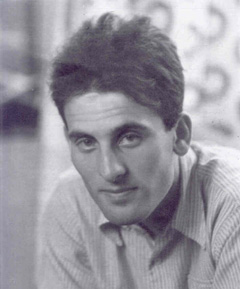
Giuseppe Paolo Stanislao "Beppo" Occhialini ForMemRS was an Italian physicist who contributed to the discovery of the pion or pi-meson decay in 1947 with César Lattes and Cecil Frank Powell, the latter winning the Nobel Prize in Physics for this work. At the time of this discovery, they were all working at the H. H. Wills Laboratory of the University of Bristol.
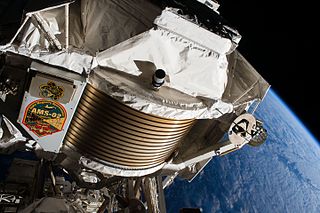
The Alpha Magnetic Spectrometer (AMS-02) is a particle physics experiment module that is mounted on the International Space Station (ISS). The experiment is a recognized CERN experiment (RE1). The module is a detector that measures antimatter in cosmic rays; this information is needed to understand the formation of the Universe and search for evidence of dark matter.
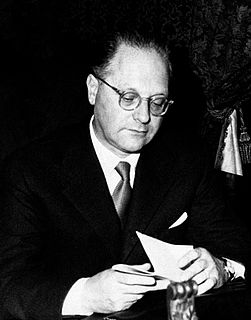
Edoardo Amaldi was an Italian physicist. He coined the term "neutrino" in conversations with Enrico Fermi distinguishing it from the heavier "neutron". He has been described as "one of the leading nuclear physicists of the twentieth century." He was involved in the anti-nuclear peace movement.

The Istituto Nazionale di Fisica Nucleare is the coordinating institution for nuclear, particle, theoretical and astroparticle physics in Italy.
Astroparticle physics, also called particle astrophysics, is a branch of particle physics that studies elementary particles of astronomical origin and their relation to astrophysics and cosmology. It is a relatively new field of research emerging at the intersection of particle physics, astronomy, astrophysics, detector physics, relativity, solid state physics, and cosmology. Partly motivated by the discovery of neutrino oscillation, the field has undergone rapid development, both theoretically and experimentally, since the early 2000s.
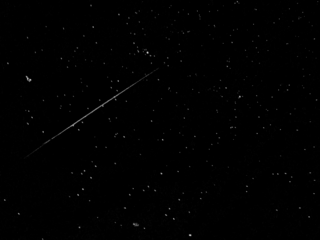
COSMO-SkyMed is an Earth-observation satellite space-based radar system funded by the Italian Ministry of Research and Ministry of Defence and conducted by the Italian Space Agency (ASI), intended for both military and civilian use. The prime contractor for the spacecraft was Thales Alenia Space. COSMO SkyMed is a constellation of four dual use Intelligence, surveillance, target acquisition, and reconnaissance (ISR) Earth observation satellites with a synthetic-aperture radar (SAR) as main payload, the result of the intuition of Giorgio Perrotta in the early nineties. The synthetic-aperture radar was developed starting in the late nineties with the SAR 2000 program funded by ASI.
Sergio Ferrara is an Italian physicist working on theoretical physics of elementary particles and mathematical physics. He is renowned for the discovery of theories introducing supersymmetry as a symmetry of elementary particles and of supergravity, the first significant extension of Einstein's general relativity, based on the principle of "local supersymmetry". He is an emeritus staff member at CERN and a professor at the University of California, Los Angeles.
COSMO-1 or COSMO-SkyMed 1 is an Italian radar imaging satellite. Launched in 2007, it was the first of four COSMO-SkyMed satellites to be placed into orbit. The spacecraft is operated by the Italian Space Agency (ASI), in conjunction with Italy's Ministry of Defence. It uses synthetic-aperture radar to produce images for civilian, commercial and military purposes.
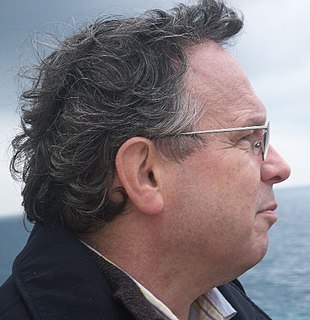
Andrea Milani Comparetti was an Italian mathematician and astronomer, based at the University of Pisa.

Luigi Broglio, was an Italian aerospace engineer, airforce lieutenant colonel and dean of the school of aeronautical engineering at the University of Rome La Sapienza. Known as "the Italian von Braun", he is best known as the architect of the San Marco programme.

Antonio Ereditato is an Italian physicist, Visiting Professor at the University of Yale, USA and Emeritus professor at the University of Bern, Switzerland, where he has been Director of the Laboratory for High Energy Physics from 2006 to 2020. He carried out research activities in the field of experimental neutrino physics, of weak interactions and strong interactions with experiments conducted at CERN, in Japan, at Fermilab in United States and at the LNGS in Italy. Ereditato has accomplished several R&D studies on particle detectors: wire chambers, calorimeters, time projection chambers, nuclear emulsions, detectors for medical applications.
PRISMA is an Italian Space Agency pre-operational and technology demonstrator mission focused on the development and delivery of hyperspectral products and the qualification of the hyperspectral payload in space.
Spaceborne Hyperspectral Applicative Land and Ocean Mission (SHALOM) is a joint mission by the Israeli Space Agency and the Italian Space Agency to develop a hyperspectral satellite.
CSES , or Zhangheng, is a Chinese–Italian space mission dedicated to monitoring electromagnetic field and waves, plasma parameters and particle fluxes induced by natural sources and artificial emitters in the near-Earth space. Austria contributes to one of the magnetometers.

Alessandro De Angelis is an Italian and Argentine physicist and astrophysicist. A Professor of Experimental Physics at the University of Padova and Professor Catedratico of Astroparticle Physics at IST Lisboa, he is mostly known for his role in the proposal, construction and data analysis of new telescopes for gamma-ray astrophysics. He is a member of Istituto nazionale di fisica nucleare (INFN), Istituto nazionale di astrofisica (INAF), Italian Physical Society (SIF), International Astronomical Union (IAU), Gruppo2003.
Stefano Vitale is an Italian Physicist and Professor emeritus of Experimental Physics at the University of Trento. He is known for his scientific contributions in the field of gravitational wave (GW) research and the successful management of international scientific projects.













